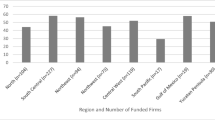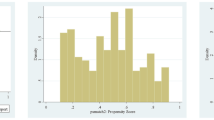Abstract
This paper contributes to the debate on the systemic effects of technology policy by investigating spillovers of pre-competitive publicly funded Industrial Collective Research (ICR) in Germany which is carried out by non-profit research institutes. Using data for 911 firms surveyed in 2006, the results show that non-actively involved firms in ICR projects use ICR results to a large extent. Almost all of these firms are engaged in collaborative research projects with non-profit research institutes. We conclude that company–scientists linkages are an important pre-requisite to absorb ICR results by non-actively involved firms in ICR projects.
Similar content being viewed by others
Notes
This paper emerged within the context of the Evaluation of the Industrial Collective Research Scheme [Durchführung der erweiterten Erfolgskontrolle beim Programm zur Förderung der Industriellen Gemeinschaftsforschung und -entwicklung (IGF)] conducted by RWI Essen and WSF Kerpen in 2005–2009 financed by the German Federal Ministry of Economics and Technology.
European Commission (1995): Green Paper on Innovation.
Another public technology program for SMEs is “Network Management East” (NEMO) that encourages the formation of regional networks of SMEs and business oriented research institutes in East Germany by the promotion of technologically and economically qualified management services (see http://www.forschungskoop.de/ for further information).
SMEs in the ICR program are defined as firms with an annual turnover below 125 million Euros including the size of subsidiaries and parent companies.
This statement is based on results of our interviews with representatives of the industrial research associations between 2005 and 2007.
AMADEUS provides longitudinal data on employment, turnover, 23 balance sheet items and 25 profit and loss account items over a period of up to 10 years. Additionally, ownership information (e.g. owner, manager, affiliates), trade descriptions and activity codes (NACE or WZ 2003 and others) and financial information are frequently updated in the database. The data set is collected by the Bureau van Dijk which cooperates in Germany with Creditreform.
A detailed descriptive analysis of the data is found in the IGF project report of RWI Essen/WSF Kerpen (2006).
We also estimated marginal effects of regressors. Marginal effects show how the dependent variable reacts if the respective regressor changes by a marginal unit. These results are available on request to the authors.
For example, biotechnology and chemical firms are managed by DECHEMA Gesellschaft für Chemische Technik und Biotechnologie e. V. (Society for Chemical Engineering and Biotechnology) with more than 5,500 private and institutional members.
The threshold value of 3.5% is usually used to identify R&D intensive manufacturing industries.
References
AiF Arbeitsgemeinschaft industrielle Forschung (ed.). (2004a). Vereinbarung über das nachweisverfahren zur bestimmung der vorhabensbezogenen aufwendungen (eigenbeteiligung) der wirtschaft für das programm zur förderung der industriellen gemeinschaftsforschung und—entwicklung (IGF). Retrieved July 16, 2009, from http://www.aif.de/igf/richtlinie.php.
AiF Arbeitsgemeinschaft industrielle Forschung (ed.). (2004b). Richtlinie über die förderung der industriellen gemeinschaftsforschung und—entwicklung (IGF). Retrieved July 16, 2009, from http://www.aif.de/igf/richtlinie.php.
AiF Arbeitsgemeinschaft industrieller Forschungsvereinigungen (ed.). (2005). English handbook 2005. Retrieved July 16, 2009, from http://www.aif.de/pdf/English_Handbook_2005.pdf.
AiF Arbeitsgemeinschaft industrieller Forschungsvereinigungen (ed.). (2006). Vereinbarung über die aufteilung der fördermittel für das programm zur förderung der industriellen gemeinschaftsforschung und—entwicklung (IGF). Retrieved July 16, 2009, from http://www.aif.de/igf/richtlinie.php.
Almus, M., & Czarnitzki, D. (2003). The effects of public R&D subsidies on firms’ innovation activities: The case of eastern Germany. Journal of Business and Economic Statistics, 21, 226–236.
Anselin, L., Varga, A., & Acs, Z. (1997). Local geographic between university research and high technology innovations. Journal of Urban Economics, 42, 422–448.
Arrow, K. J. (1963). Uncertainty and the welfare economics of medical care. American Economic Review, 53, 941–973.
Audretsch, D. B., & Feldman, M. P. (1996). R&D spillovers and the geography of innovation and production. American Economic Review, 86, 630–640.
Belderbos, R., Carree, M., & Lokshin, B. (2004). Cooperative R&D and firm performance. Research Policy, 33, 1477–1492.
Bonaccorsi, A., & Piccaluga, A. (1994). A theoretical framework for the evaluation of university–industry relationships. R&D Management, 24, 229–247.
Bound, J., Jaeger, D. A., & Baker, R. M. (1995). Problems with instrumental variables estimation when the correlation between the instruments and the endogenous explanatory variable is weak. Journal of the American Statistical Association, 90, 443–450.
Bozeman, B. (2000). Technology transfer and public policy: A review of research and theory. Research Policy, 29, 627–655.
Busom, I. (2000). An empirical evaluation of the effects of R&D subsidies. Economics of Innovation and New Technology, 9, 111–148.
Caloghirou, Y., Tsakanikas, A., & Vonortas, N. S. (2001). University–industry cooperation in the context of the European framework programmes. Journal of Technology Transfer, 26, 153–161.
Cassiman, B., Veugelers, R., & Zuniga, M. P. (2007). Science linkages and innovation performance: An analysis on CIS-3 firms in Belgium. IESE working paper no. 671. Retrieved July 16, 2009, from http://ssrn.com/abstract=982321.
Cockburn, I., & Henderson, R. (1998). Absorptive capacity, coauthoring behaviour and the organization of research in drug discovery. Journal of Industrial Economics, 46, 157–182.
Cohen, W. M., & Levinthal, D. (1989). Innovation and learning: The two faces of R&D. The Economic Journal, 99, 569–596.
Cohen, W. M., & Levinthal, D. (1990). Absorptive capacity: A new perspective on learning and innovation. Administrative Science Quarterly, 35, 128–152.
Czarnitzki, D., Ebersberger, B., & Fier, A. (2007). The relationship between R&D collaboration, subsidies and R&D performance: Empirical evidence from Finland and Germany. Journal of Applied Econometrics, 22, 1347–1366.
David, P. A., Hall, B. H., & Toole, A. A. (2000). Is public R&D a complement or a substitute for private R&D. Research Policy, 29, 497–529.
Engel, D., & Heneric, O. (2005). Do university based regions really attract outside entrepreneurs—The case of the German biotechnology industry. ZEW discussion paper no. 05–61. Mannheim.
Etzkowitz, H. (1998). The norms of entrepreneurial science: Cognitive effects of the new university–industry linkages. Research Policy, 27, 823–833.
European Commission. (1995). Green paper on Innovation. Retrieved July 16, 2009, from http://europa.eu/documents/comm/green_papers/index_en.htm#2005.
Fogarthy, M. S., Sinha, A. K., & Jaffe, A. B. (2006). ATP and the U.S. innovation system: A methodology for identifying enabling R&D spillovers networks. NIST GCR 06-895. National Institute of Standards and Technology, US Department of Commerce.
Gibson, D. V., & Rogers, E. M. (1994). R&D collaborations on trial. Boston, MA: Harvard Business School Press.
Griliches, Z. (1992). The search for R&D spillovers. Scandinavian Journal of Economics, 94, 29–47.
Grimaldi, R., & von Tunzelmann, N. (2002). Assessing Collaborative, Pre-competitive R&D Projects: The Case of the UK LINK Scheme. R&D Management, 32, 165–173.
Grimaldi, R., & von Tunzelmann, N. (2003). Sectoral determinants of performance in collaborative R&D projects. International Journal of Technology Management, 25, 767–778.
Janz, N. (2000). Quellen für innovationen: Analyse der ZEW-innovationserhebungen 1999 im Verarbeitenden Gewerbe und im Dienstleistungssektor. ZEW Dokumentation Nr. 00-10. Mannheim.
Kamien, M., & Zang, I. (2000). Meet me halfway: Research joint ventures and absorptive capacity. International Journal of Industrial Organization, 18, 995–1012.
Kobe, G. (1998). The 42-volt revolution–automobile battery voltage increase—Cover story. August: Automotive Industries Magazine.
Lach, S. (2002). Do R&D subsidies stimulate or displace private R&D? Evidence from Israel. Journal of Industrial Economics, 50, 369–390.
Lageman, B., Friedrich, W., Koerbel, M., Oberheitmann, A., & Welter, F. (1995). Der volkswirtschaftliche Nutzen der industriellen Gemeinschaftsforschung für die mittelständische Industrie (Vol. 15). Essen: Untersuchungen des Rheinisch-Westfälischen Instituts für Wirtschaftsforschung, RWI press.
Mohnen, P., & Hoareau, C. (2003). What type of enterprise forges close links with universities and government labs? Evidence from CIS 2. Managerial and Decision Economics, 24, 133–145.
Nonaka, I., Takeuchi, H., & Umemoto, K. (1996). A theory of knowledge creation. International Journal of Technology Management, 11, 833–845. Special Issue on Unlearning and Learning for Technological Innovation.
Nooteboom, B. (1994). Innovation and diffusion in small firms: Theory and practice. Small Business Economics, 6, 327–348.
Oliver, A. L. (2008). University based spin offs. In H. Patzelt & T. Brenner (Eds.), Handbook of biotech-entrepreneurship (Vol. 4). Springer: International Handbook Series on Entrepreneurship, Berlin.
Polanyi, M. (1967). The tacit dimension. New York: Anchor Books.
Rogers, E. M., & Shoemaker, F. F. (1971). Communication of innovations: A cross-cultural approach. New York: Free Press.
RWI Essen & WSF Kerpen (2006). Erweiterte erfolgskontrolle beim programm zur förderung der IGF im Zeitraum 2005–2009 (vol 2). Zwischenbericht, Schwerpunktthema Unternehmensbefragung. Retrieved July 16, 2009, from http://www.aif.de/igf/esk.php.
RWI Essen & WSF Kerpen. (2007). Erweiterte erfolgskontrolle beim programm zur förderung der IGF im Zeitraum 2005–2009. Zwischenbilanz, RWI: Projektberichte.
Sellenthin, M. O. (2009). Technology transfer offices and university patenting in Sweden and Germany, Journal of Technology Transfer. Published online 03 march 2009.
Stephan, P. E. (1996). Company-scientist links: The case of biotechnology. American Economic Review, 86, 641–652.
Tassey, G. (2003). Methods for assessing the economic impacts of government R&D. NIST planning report 03-1. National Institute of Standards and Technology (NIST), Department of Commerce.
Tassey, G. (2005). Underinvestment in public good technologies. Journal of Technology Transfer, 30, 89–113.
Toole, A. A., & Czarnitzki, D. (2007). Biological academic entrepreneurship through the SBIR program. Journal of Economic Behavior & Organization, 63, 716–738.
Wallsten, S. J. (2000). The small business innovation research program: Encouraging technological innovation and commercialization in small firms? Rand Journal of Economics, 31, 82–100.
Walter, A. (2003). Technologietransfer zwischen wissenschaft und wirtschaft (Vol. 106). Wiesbaden: Beiträge zur betriebswirtschaftlichen Forschung, DUV.
Welter, F. (1995). Die industrielle gemeinschaftsforschung als kooperative forschungsstrategie für kleine und mittlere unternehmen. Internationales Gewerbearchiv, 43, 47–56.
Zucker, L. G., Darby, M. R., & Amstrong, J. S. (1998). Geographically localized knowledge: Spillovers or market? Economic Inquiry, 36, 65–86.
Zucker, L. G., Darby, M. R., & Amstrong, J. S. (2002). Commercialisation knowledge: University science, knowledge capture, and firm performance in biotechnology. Management Science, 48, 138–153.
Acknowledgments
Special thanks are expressed to the project leader Bernhard Lageman (RWI) for research guidance and support. We also thank Rainer Graskamp, Joel Stiebale (RWI) and two anonymous reviewers for helpful comments and Eoin Ryan for proofreading the paper.
Author information
Authors and Affiliations
Corresponding author
Rights and permissions
About this article
Cite this article
Eckl, V.C., Engel, D. How to benefit from publicly funded pre-competitive research: an empirical investigation for Germany’s ICR program. J Technol Transf 36, 292–315 (2011). https://doi.org/10.1007/s10961-009-9135-1
Published:
Issue Date:
DOI: https://doi.org/10.1007/s10961-009-9135-1
Keywords
- Technology policy
- Pre-competitive research
- Evaluation
- Public–private relationship
- Absorptive capacity
- Tacit knowledge




